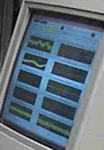


FDA
Home Page | CDRH Home Page | Search
| CDRH
A-Z Index | Contact CDRH
![]()
   |
| FDA
Home Page | CDRH Home Page | Search
| CDRH
A-Z Index | Contact CDRH
|
 |
Director: Alford R. Taylor Jr.
The mission of the Division is to apply the electronics, software engineering, and systems engineering body of knowledge to the regulation of medical devices and electronic products that emit radiation. We fulfill our mission by providing highly specialized technical support to Center and Agency regulatory activities in the form of:
The underlying theme of much of our work is product realization, a term used by engineers to describe the process of converting a design concept into a viable product. While we recognize that cutting edge technologies are the focus of much regulatory attention in FDA, and properly so, our interest is in how these new technologies are reduced to practice. Product realization encompasses all phases of the product life cycle and all aspects of the product manufacturer’s business, from research and development through procurement, production, and ongoing customer support.
Our research program reflects our abiding interest in product realization, and focuses on improving the engineering practices and processes of regulated industry. Particular emphasis is placed on improving capabilities in measurement and analysis of medical device performance. The technologies and methods we explore may be cutting edge or tried and true and may be found in academia, industry (medical device or other industry sectors), military, or clinical research programs.
Our highly focused stakeholder focus permits us to provide a timely and balanced consulting review function within the CDRH and to other parts of the agency (both CBER and CDER) for software, electronic and systems engineering issues.
Electronics Laboratory
The Electronics Laboratory embraces three key aspects of medical electronics having immediate applicability to the mission of the Center.
 |
|
Software Laboratory
The work of this laboratory is focused on developing analytical methods and tools for assuring the safety and security of software used for medical purposes. This work is highly collaborative, drawing heavily on research in academia and industry practices in the area of high confidence software and embedded systems. Such methods include modeling techniques that can be used to assess and certify the safety and security of medical software. Areas of focus include:
|
 |
This program is important to public health because more and more medical devices
rely on software as a means of providing robust patient care in terms of diagnosis,
monitoring, or therapy. Software development methods simply haven't kept pace
with the complexities of today’s or future devices. Only by focusing on
new software development methods, with an emphasis on safety and security, can
this challenge be addressed. A byproduct of this program is the cross-pollination
of academia and industry personnel which can result in the industry adopting
more effective design methods, which in turn can result in faster regulatory
reviews and reduced recalls and associated expenses. Clearly, device safety
and patient information security is essential to quality patient care and public
confidence in the health care systems.
Systems Engineering Laboratory
This laboratory applies a systems engineering perspective to medical device
regulatory issues. The laboratory is currently focusing in two distinct areas.
 |
|
Research Program Areas:
Science and Engineering Staff Matrix
![]()
CDRH Home Page | CDRH A-Z Index | Contact CDRH | Accessibility | Disclaimer
FDA Home Page | Search FDA Site | FDA A-Z Index | Contact FDA | HHS Home Page
Center for Devices and Radiological Health / CDRH